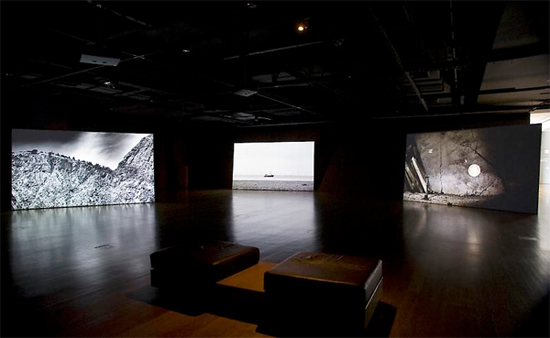Currently on view: New York
James Cohan Gallery
533 West 26th Street New York NY 10001
17 February – 26 March 2011

James Cohan’s New York gallery is currently showing works by Hiraki Sawa, a solo exhibition appropriately entitled “O†(notice the italisation), which gives us an accurate indication of the topic and format of the work therein, mostly all round, turning or in a state of flux.
Covering three rooms at James Cohan, O firstly introduces “Wax 1-24â€, a series of framed drawings of the moon in its various phases. Upon closer inspection, we notice the moons have been tempered with, and were originally drawn as full. Sawa has partly-erased all but one of his moons, a seemingly destructive act to render all the lunar states in full cycle. Here the work’s title is eloquent as it justly refers to the eraser’s material, as much as to the scientific naming of the sunlight’s reflections on the moon (waxing crescent, waxing gibbous). This reversible destructive / creative act becomes even more layered if alluding to another instance of deletion in the art world: Rauschenberg’s erased De Kooning.

Cohan’s second room features Sawa’s title piece, O, a multi-channel video installation originally commissioned by the Queensland Art Gallery for The 6th Asia Pacific Triennial of Contemporary Art in Brisbane, Australia. 13 videos populate the space, from ten wall-embedded monitors to three large-scale projections on angled, floor-standing panels. Proposed as black and white tableaux, each of the monitors isolates an object from the more elaborate compositions on the large-scale panels. A bell, a plate, a lightbulb each take residence on a separate monitor, spinning in a seamless video loop to quietly defy any law of gravity, friction or linear timescale. Also spinning, but in physical space, are five mini-speakers spread around the room. Each one emitting different sounds, the speaker’s rotations adding directional variations to the installation’s audio partition. Back on the large-scale projections, we find similar elements to the ones on the monitors, slowly amalgamating with even more objects of our natural and cultural world. However, these objects aren’t cast as protagonists but more as film extras, part of a much bigger picture. Seamlessly integrated within landscapes, interiors, and other backdrops, Sawa’s moving collages never impose a specific narrative, yet simultaneously evoke feelings of familiarity and melancholy.

The third and final room in the exhibition displays Sawa’s most recent work. A cinematic single-channel video projection, “Did I?†reveals the artist presumably in his studio, busy erasing a moon or other drawing, this confirmed by the loud rubbing noises permeating from the speakers. The highly graphic style of this piece at first surprises, because it states such a visual contrast to the previous room’s mostly lens-best footage. Perhaps this way opening to a new direction in Sawa’s work to come, “Did I?†nevertheless operates a closure in the current exhibition. As with the rest of the show, the understated title easily spins in one’s mind, into “I didâ€, and celebrates erasure as a fully intended gesture, here repeated over and over in the projection’s video loop.
From circular moons, spinning objects, to open-ended narratives, it seems a challenge to find a better title than “O†for Sawa’s exhibition. This leitmotiv on cycles and invertible structures is held together by an impeccable presentation, to allow a contemplative viewing, undistracted by the technical paraphernalia usually so present in video works. This is what ultimately endures in our memory of Sawa’s show at James Cohan, that such craftsmanship has been invested in a subject matter so frugal, self-effacing if you pardon the pun. As if the artist is suggesting that if one is to say nothing, better to say it well.
by Oli Sorenson
